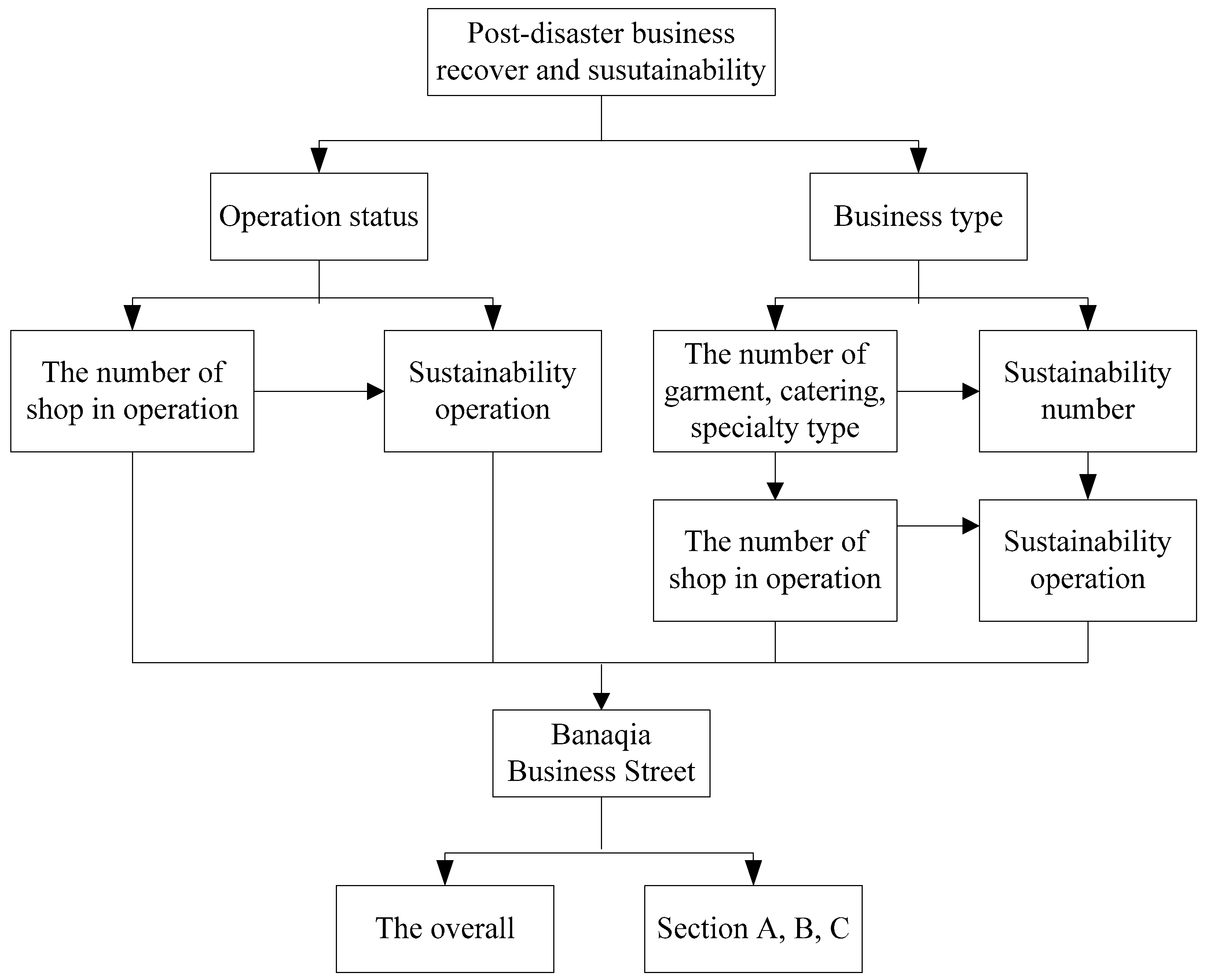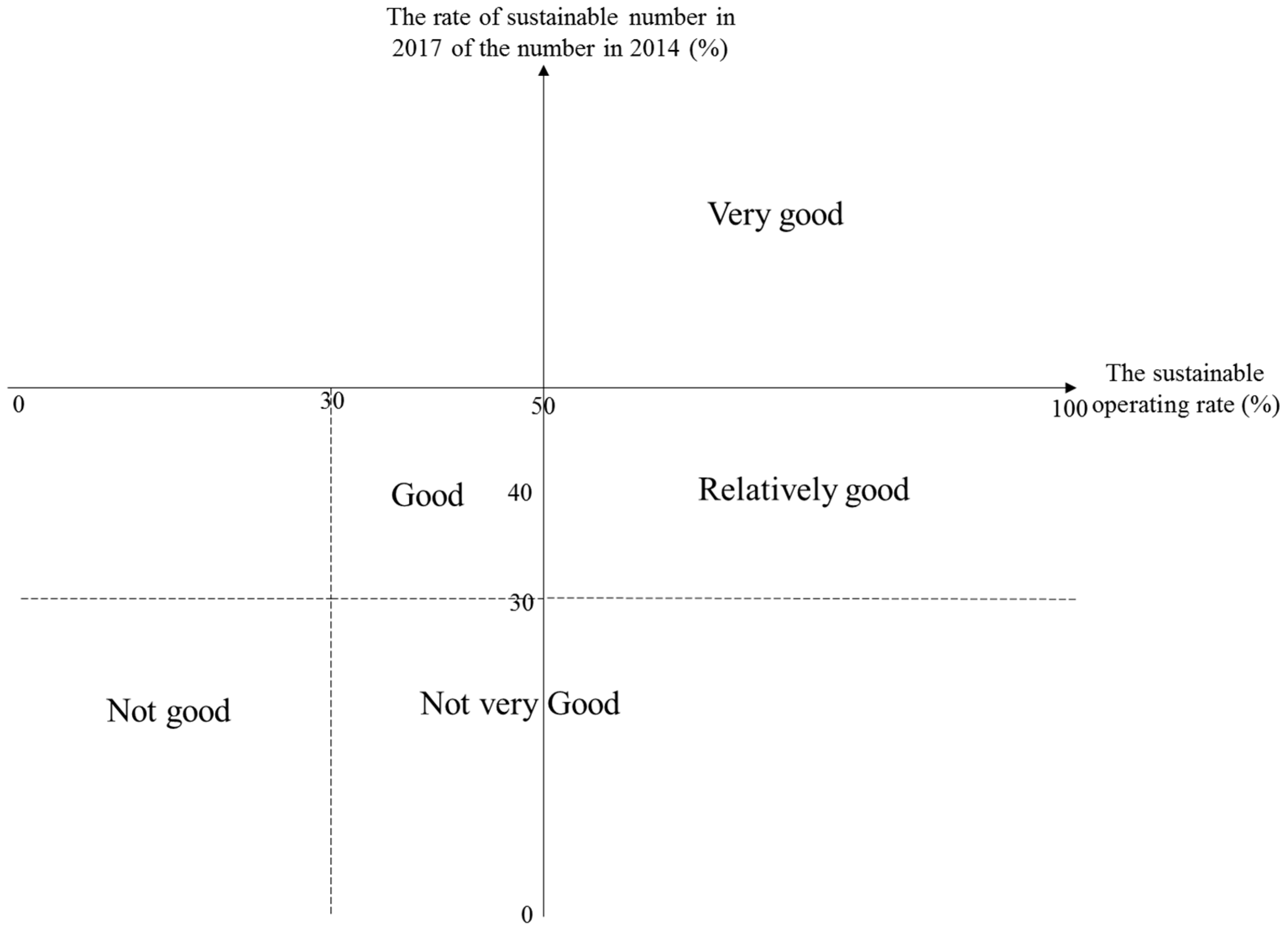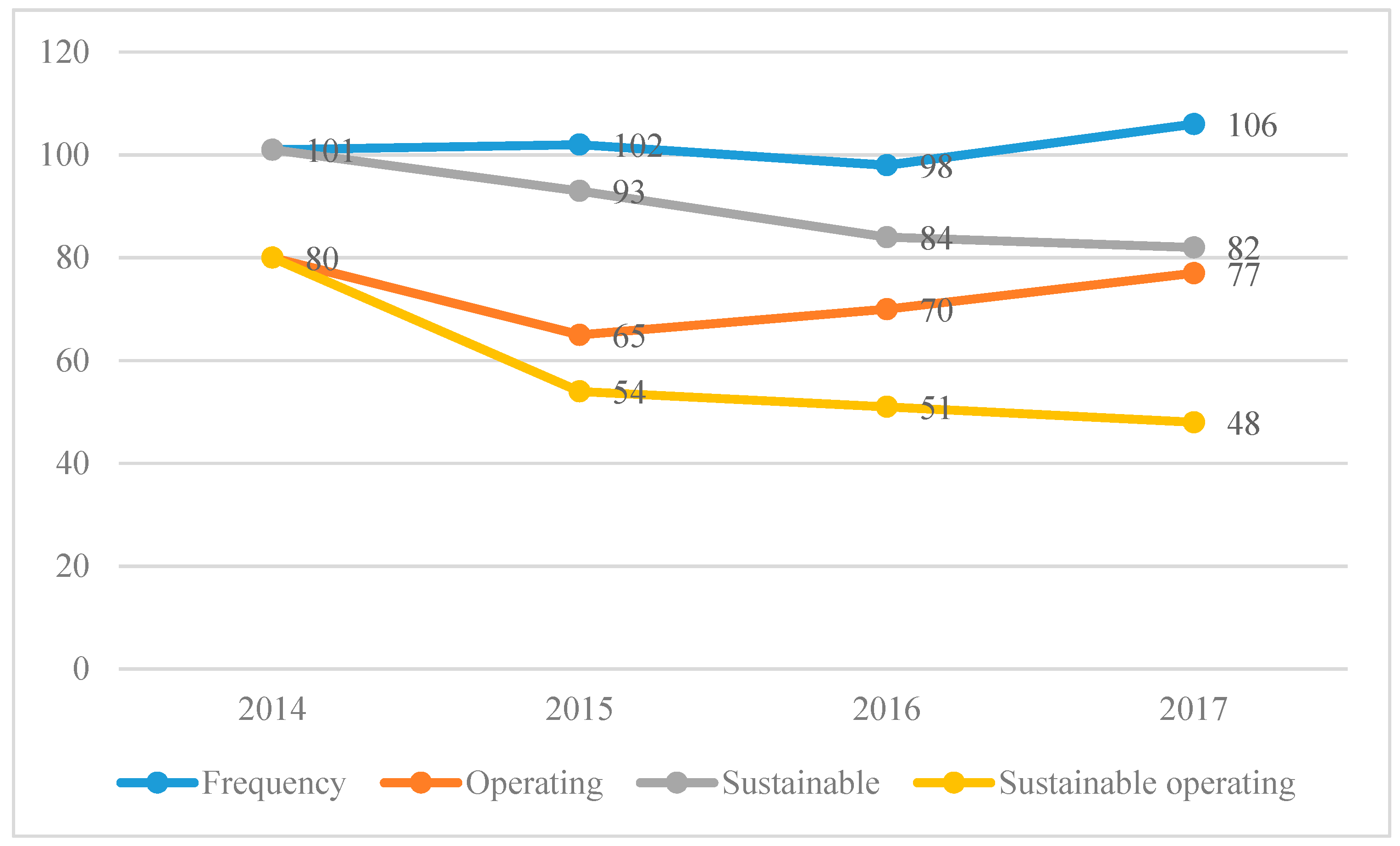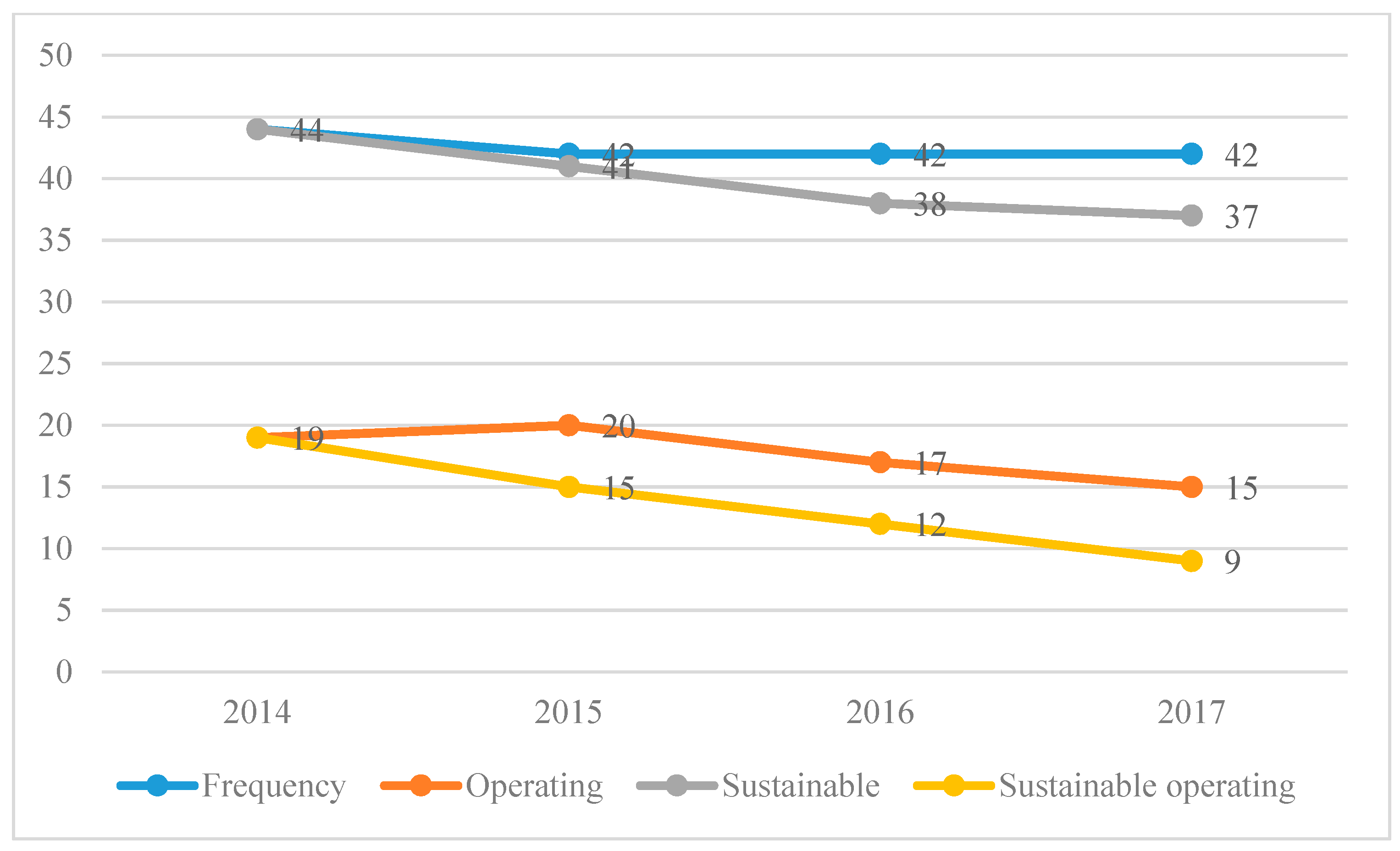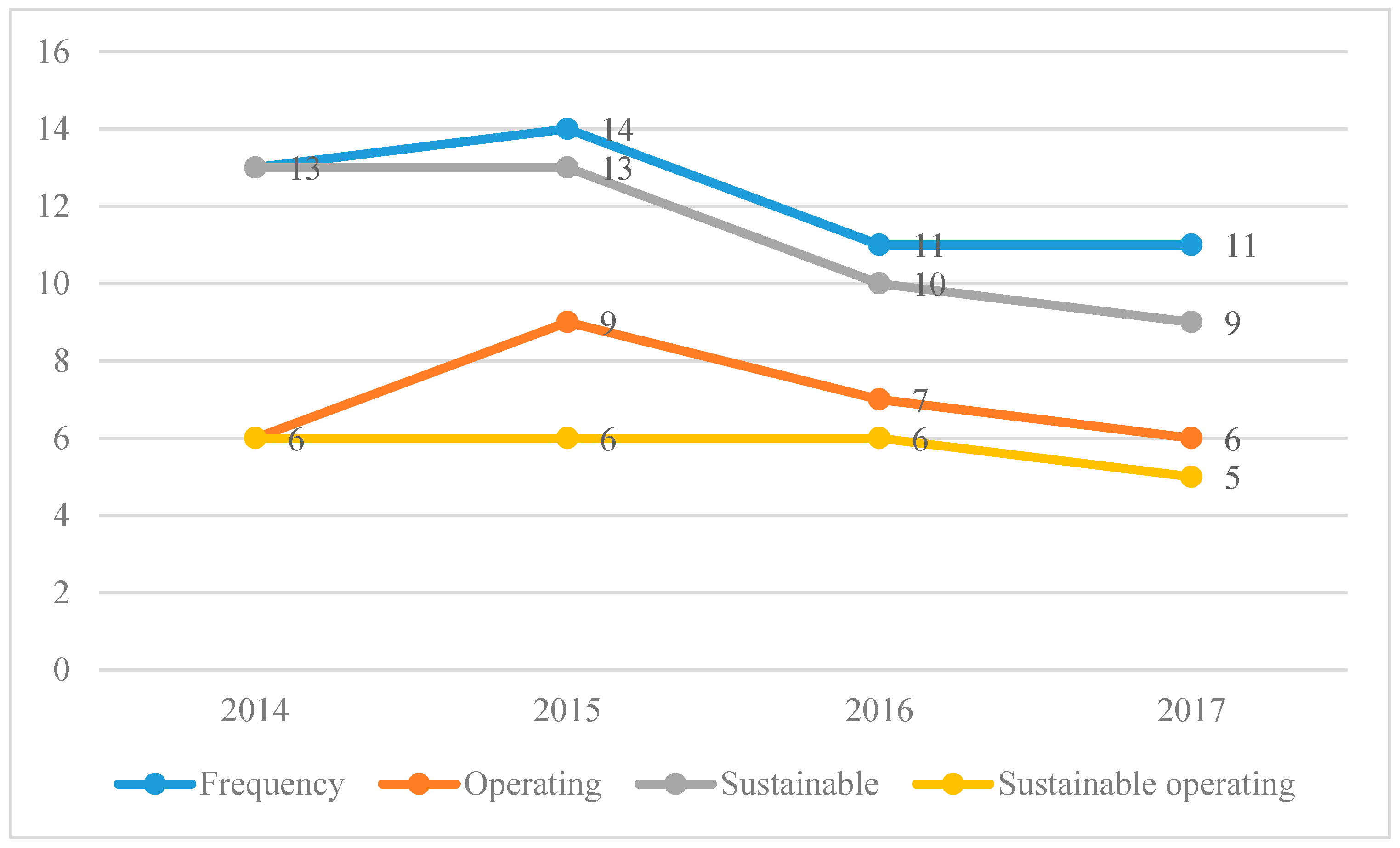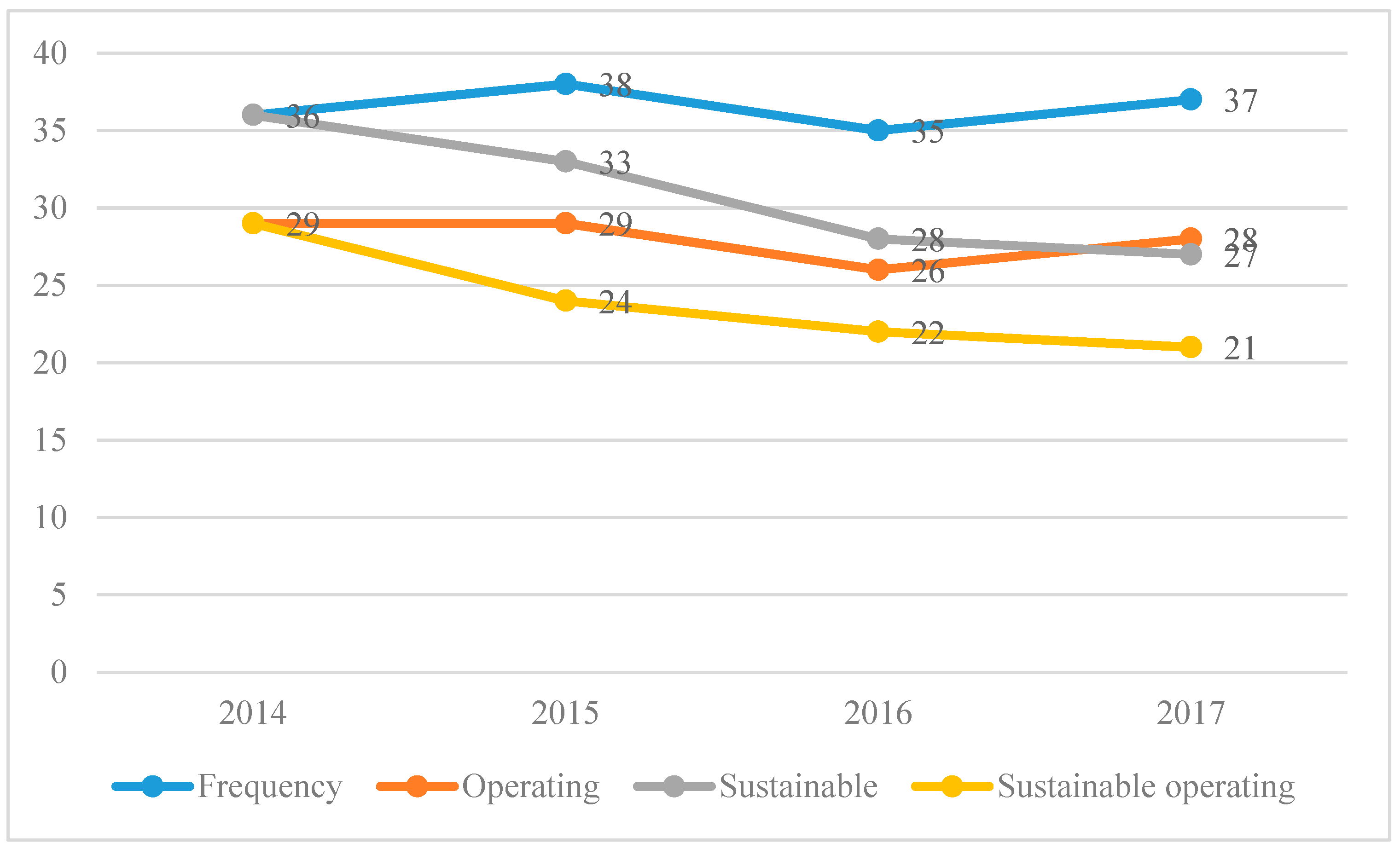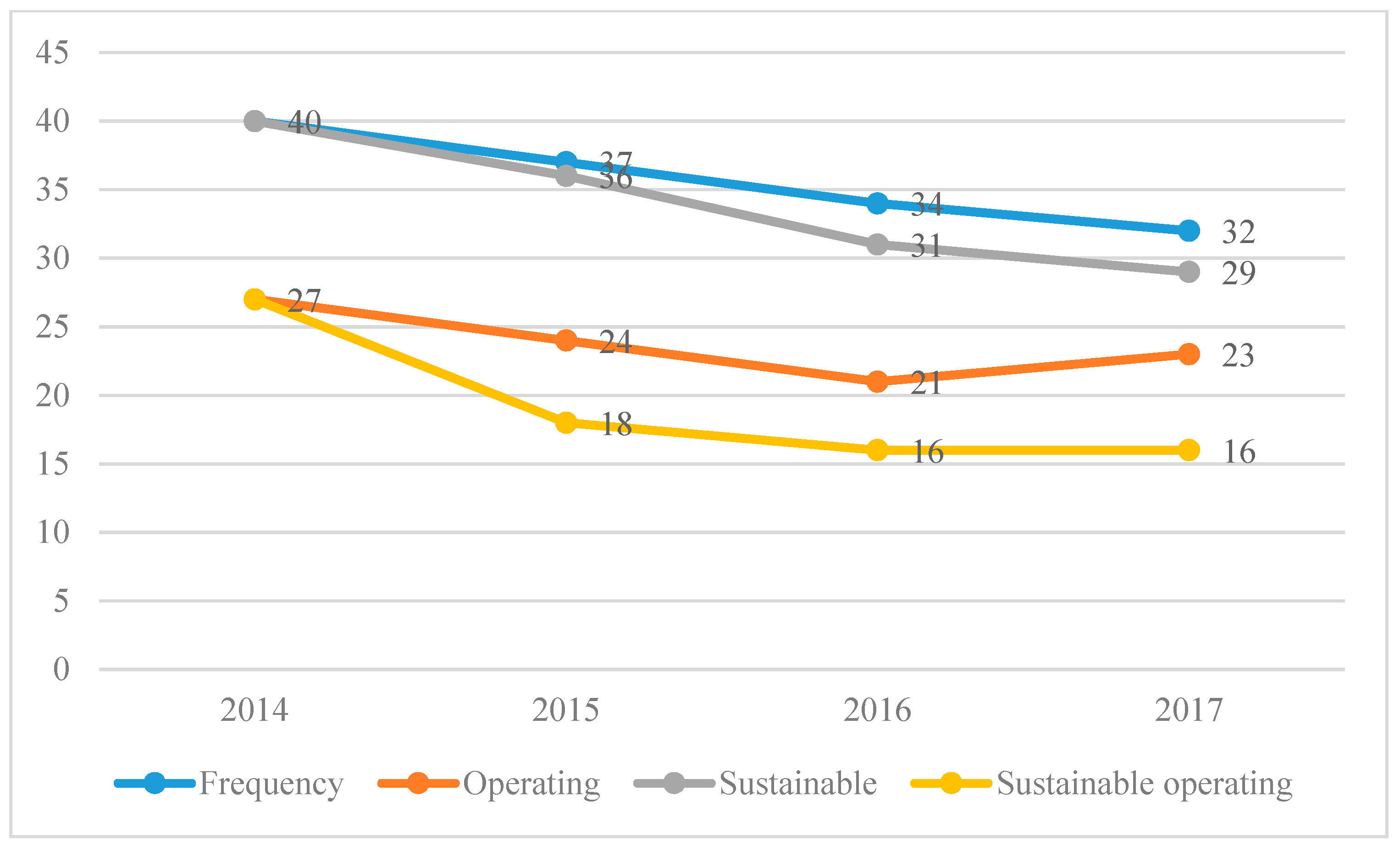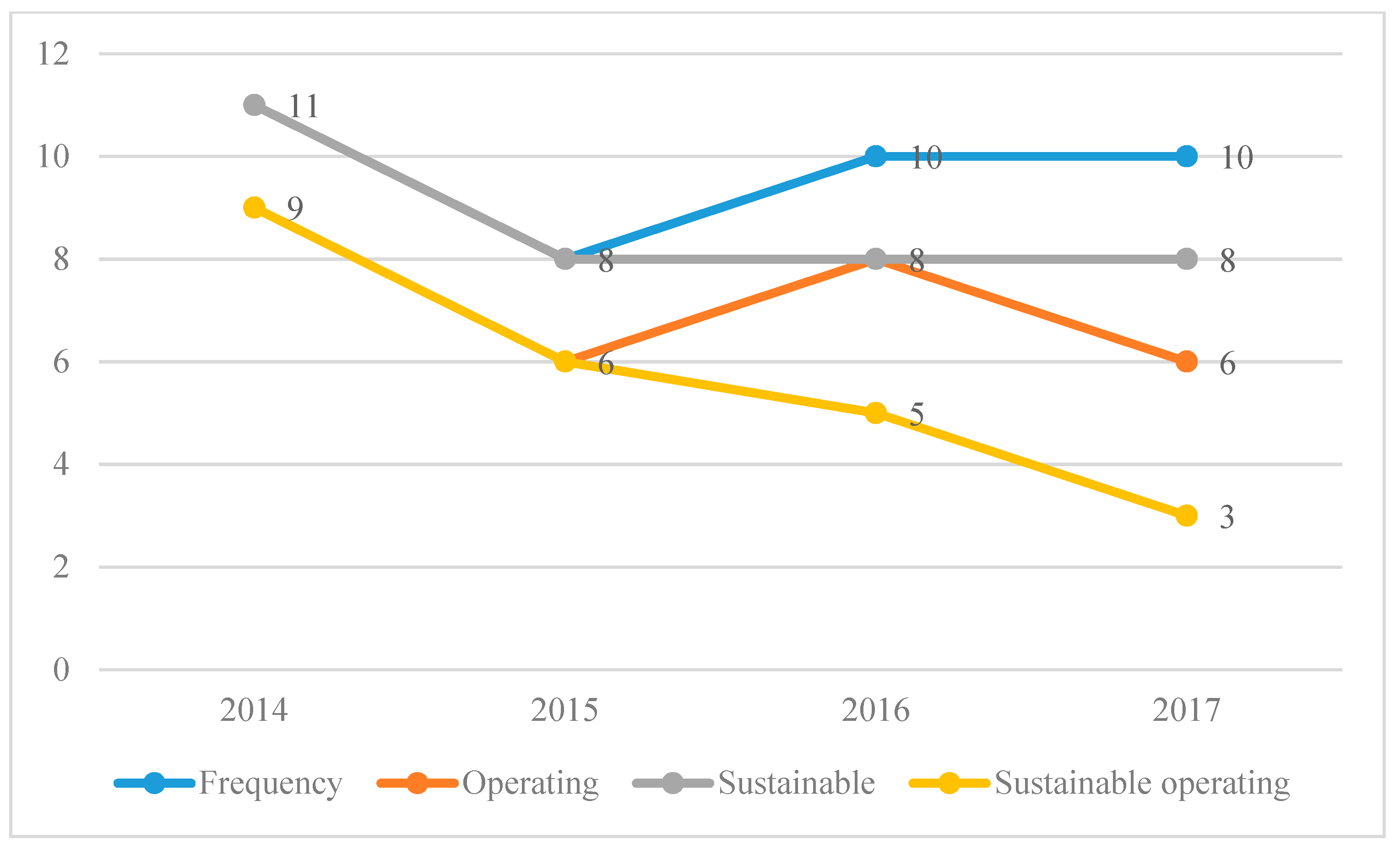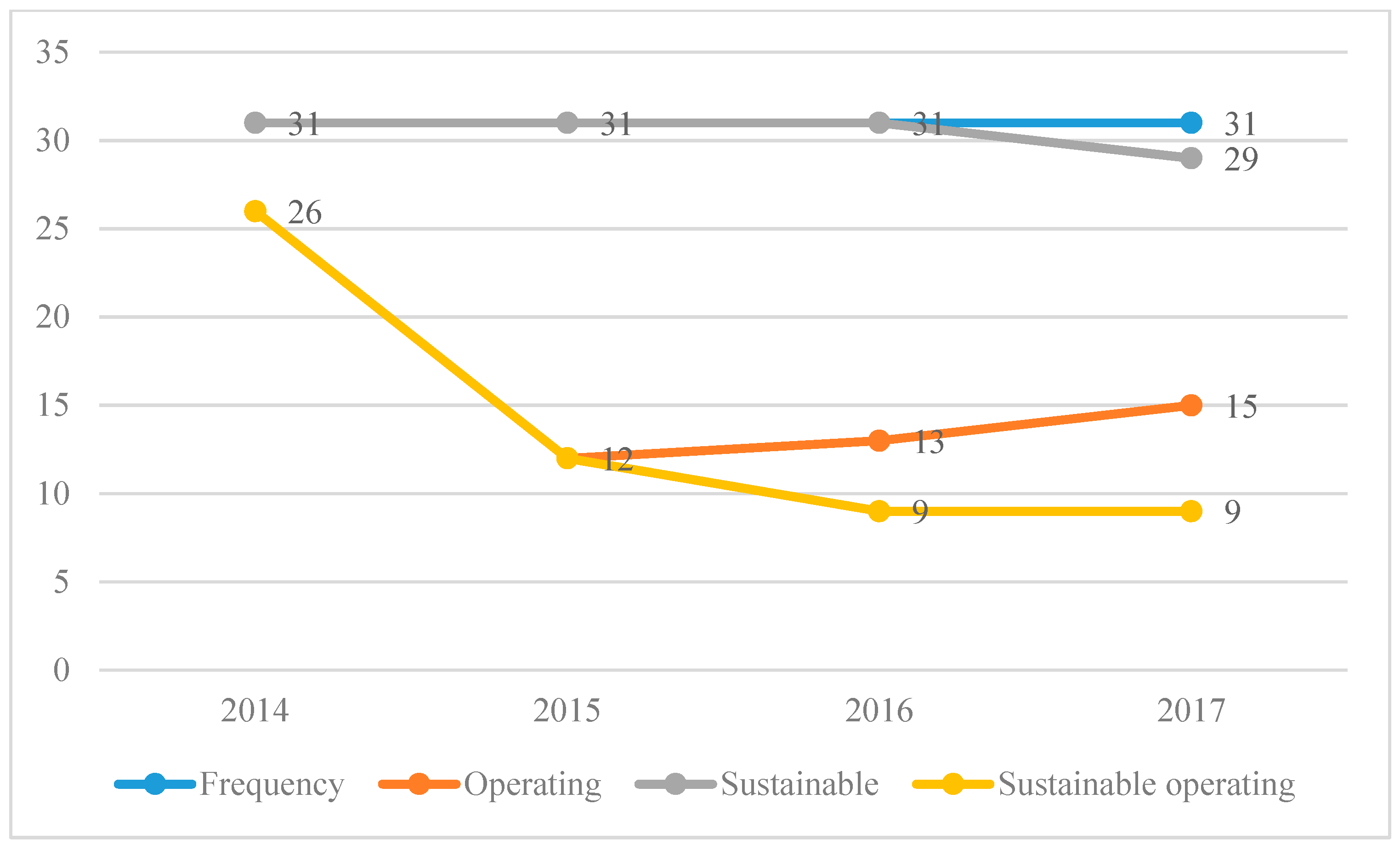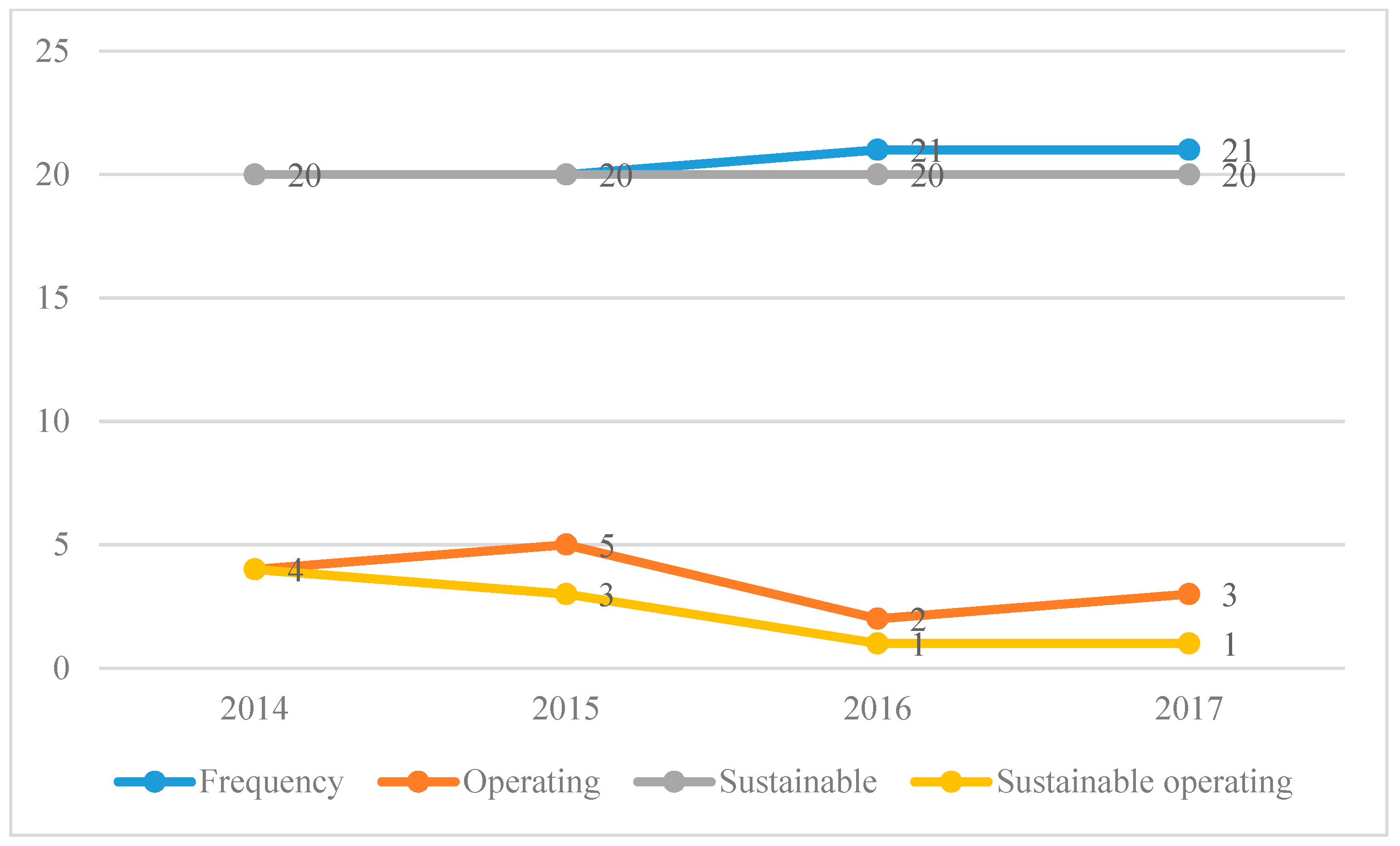1. Introduction
When a community encounters disasters, the ability of local businesses to survive is an important factor in the recovery process because businesses play a crucial socio-economic role in the community by providing jobs, goods and services, and tax revenue [
1]. However, post-disaster restoration is affected not only by direct physical impact on businesses at the time of events, but also by the ways in which disasters create long-term disturbance to business owners [
2]. Disasters may cause extended periods of business interruption, logistic difficulties, revenue decline due to the loss of customers and other operational issues [
2].
Disaster research has focused on documenting the ways in which hazards affect individuals, households, communities, and public sector organizations [
3,
4,
5]. Some have looked at how private sector entities prepare for, respond to, and recover from disasters [
6,
7]. Substantial numbers of empirical work on natural disasters [
8,
9] not only have dealt with the issues of small communities and firms [
10,
11], but have included governments, large cites and multi-national corporations as well [
3]. An important difference between the sizes is that smaller communities tend to have fewer resources than their larger counterparts [
12].
Some research has concentrated on disasters and their impact on businesses. Researchers at the Disaster Research Center at the University of Delaware investigated the impact of major disasters, including the 1993 Midwest floods, Hurricane Andrew in 1992, and the Loma Prieta and Northridge earthquakes [
6,
13]. They found that direct physical damage was only one of the many factors influencing business loss and recovery. Disruption to infrastructure services, such as utilities and transportation, could have a significant consequence as well. Other operational problems, such as difficulties with supplies and shipment, or drops in customer traffic and demand, could also be phenomenal [
14]. Small businesses, particularly in developing countries, have a higher probability of being located in hazard prone areas, equipped with unsafe business facilities and not having enough human and financial resources, as well as the necessary knowledge of their vulnerability in the face of hazards [
15,
16,
17].
In addition, business characteristics such as primary market and ownership structures may also play an important role in post disaster recovery and operation. Sole proprietorship and local businesses are less likely to get access to multiple locations once a disaster strikes; as a result, they are more vulnerable to disasters [
18]. Businesses that depended chiefly on non-local markets tend to be better than home-based ones precisely because their products or services are tied to a wider range of regional or national areas where disaster-related problems are relatively small [
19,
20]. Similarly, joint ventures and non-local market businesses are more likely to achieve sustainable operations after a disaster because they can help each other when one of them falls into poor operation. In addition, disaster impact, disruption of raw material supply, reduced employees, and loss of customers appear to have a significant relationship with a firm’s ability to recover from a disaster [
18,
21].
There are few studies on post-disaster business sustainable operations. Most research is on sustainable business operations, focused on how businesses improve their development level and competitiveness in non-disaster settings [
22,
23]. If it takes disasters into consideration, the sustainable operation of a business that initially survived a disaster will generally have a similar meaning to long-term business recovery after disaster; namely, how short-term survived businesses can achieve long-term recovery after a disaster.
This paper focused on the Banaqia commercial streets as a study area and performed a four-year longitudinal study researching the post-disaster sustainable development of Banaqia Business Street in New Beichuan City. The research contributes to disaster literature and practice in three areas. First, it helps to inform the policy making of post-disaster reconstruction in developing countries such as China. Second, it adds insights into how small businesses are impacted by disasters and recover from the shocks. Third, it also sheds light on the understanding of small business unsustainability in new planned cities—which burgeon during the rapid urbanization in China.
Based on the disaster recovery and sustainable development literature reviewed above, an analytical framework was developed (
Figure 1) that contains four components of post-disaster business recovery and sustainability development: (1) the temporal fluctuation of the number of stores in Banaqia Business Street; (2) the sustainable operation rate of shops in Banaqia Business Street; (3) the evolution of business type in Banaqia; and (4) the sustainable development of business type in Banaqia.
This paper was organized into the following sections. It commences with an introduction of the Banaqia district and the research methods employed. It then analyzes the spatial patterns of different business types and the sustainable development of the stores located in three districts in Banaqia. It concludes with a discussion of the spatiotemporal transformation of small businesses in Banaqia and other similar areas in China.
2. Background
On 12 May 2008, a devastating earthquake hit the southwest of China. Over 60,000 people were killed, around 17,000 were declared missing, and almost 400,000 were injured. The disaster resulted in 23.17 billion RMB of direct losses due to structural damages [
24]. Shortly after the earthquake, the central government of China coordinated a nationwide effort to help the earthquake-impacted areas recover [
25].
The capital of Beichuan County, which accounts for 58.67% of the total population, was the most devastated major town, with 15,646 fatalities and 4932 missing. Beichuan County was buried by a landslide and became inhabitable. It was ranked as one of the most damaged areas. Later, the damaged city was preserved and protected as an earthquake museum.
Beichuan City is the only Qiang Autonomous County in China. For the great importance of the development and revitalization of ethnic minorities, and protecting the ethnic cultural heritage of Qiang nationally, Beichuan City’s recovery and reconstruction drew national attention. After the earthquake, the Party Central Committee and the State Council gave instructions to “Make sure to construct Beichuan well” and “Construct a new Beichuan”. Beichuan City’s reconstruction was to be the symbol of the whole post-disaster reconstruction. However, experts repeatedly demonstrated to the government that Beichuan City could not be reconstructed locally, and determined “2 km northeast of Anchang Town” as the best site for New Beichuan City. The selected site is 23 km from the old city. Many experts, including six academics of the Chinese Academy of Sciences and Chinese Academy of Engineering, participated in New Beichuan City’s planning and design.
In total, 218 projects were started simultaneously through the hard work of 30,000 construction workers, using more than 1000 tower cranes. After 15 months, all projects were completed. The construction of New Beichuan City was something of a miracle in the history of Chinese urban construction. The built-up area covers 4 km
2 (
Figure 2), with a resident population of 35,000. Within New Beichuan City, we can see a lot of buildings with Qiang characteristics have been built, such as Banaqia Business Street, and Beichuan Museum, which has greatly promoted the quality of the physical environment of the city. The appearance and layout of the city even surpasses some central and eastern cities of the same size.
Town planning and construction are mainly initiated by top-down planning and discussions among governmental officials and experts, lacking the natural process whereby human settlements form, develop, and prosper. Since Beichuan was the only Qiang minority autonomous county in China, New Beichuan City was designed to demonstrate its inheritance and protect the Qiang ethnic culture. It was also designed as a tourism and eco-city. In other words, commerce and tourism are both crucial industries for the city. Among ten landmark buildings throughout the city, Banaqia Commercial Street is the most influential in terms of the role of promoting local economy and vitalizing the city. Furthermore, it may be concluded that the overall prospect of the commercial and tourism industries largely depends on whether Banaqia can develop sustainably.
Research regarding new businesses in rebuilt cities following disasters is relatively rare, yet of great importance. In China, central commercial districts represent the overall image and general competiveness of a city. The recent publicity of these districts in new town planning also reflects urban development and economic boom after the market reform in China in 1980s. Therefore, these featured commercial areas are significant for the rebuilt counties after the earthquake. For instance, Banaqia’s commercial areas largely serve as an axis of the New Beichuan City, lead economic development, and grow as the city expands. According to planning documents, the New Beichuan City would accomplish several new goals: the transformation of the developmental patterns of mountainous urban areas in Beichuan, the promotion of labor force migration from rural to urban areas, and the development of commercial, vacation, tourism, and other service-related industries. These industries are crucial to new towns; most importantly, Banaqia is home to these industries and thus plays a pivotal role in the spatial layout of urban functions.
Banaqia Business Street is located in the center of the new town and is designed as a commercial complex that offers cultural related products, shopping, catering, and entertainment businesses. The local government and the public had high expectations of the role of this business district in revitalizing the local economy. When Banaqia started to invite businesses in April 2011, more than 8000 merchants came to investigate, and 110 businesses from Mianyang, Shanghai, Chongqing, and other provinces determined to settle in Banaqia. In total, 110 (out of a possible 156) shops were in operation. Eighty percent of these were catering services, or souvenir related to Qiang culture, selling items such as Qiang silk, Qiang tea, and Qiang foods [
26]. Banaqia has three sections. Section A, near the tourism district, focuses on Qiang ethnic culture and products. Section C, near the river, is designed as the sector for catering, recreation and entertainment. Section B, located between A and C, is a commercial complex, designed as a space where traditional culture and modern life integrate.
5. Discussions
We have shown that the New Beichuan City consisted of residential, institutional, Banaqia commercial, industrial park, and tourism areas. Most business activities occur in Banaqia commercial streets. The residents of the new city come from the disaster-stricken areas and Huangtu Town. Residential areas were largely located in the northern and southern parts of the city and divide Beichuan County into three separate regions: old Beichuan resettlement, Huangtu resettlement, and the tourism district. Community businesses were situated in the two resettlement areas, and Banaqia includes small businesses that accommodate tourists. Our four-year survey indicates that the developmental patterns and types of stores in the different districts are distinct. While this paper focuses primarily on Banaqia commercial development, the discussions of the recovery of community businesses in the resettlement areas are being formulated in another paper.
The analysis of the business operation of Banaqia shows that initial merchant invitation was conducted according to planning. However, after several years of operations, it is noted that Banaqia did not develop into a cultural and commercial area in western Sichuan, featuring Qiang culture exhibitions, shopping, entertainment, and catering, as was originally envisaged by the post-disaster recovery planning. Furthermore, numerous businesses have shut down for various reasons, and business types are inclined to be homogeneous, with the majority including local food, catering and clothes; the other types are minority. Meanwhile, entertainment businesses, such as bars, are largely unsustainable and changed into shops selling milk teas. Several commercial facilities transformed, and their commercial function has deteriorated. Additionally, the closure of shops possibly decreases the number of retail stores, threatening the other business owners and hampering the economic activities in Banaqia. Economic decline may produce an increasing number of vacant stores that induces the discontinuity of businesses. This discontinuity creates an area that does not have a commercial function or whose initial functioning falls, thereby rendering Banaqia as a place where there is no memory in collective cognition or a failed region. The spatial analysis of business operation status and types indicate that there exist apparent distinctions regarding business rates in different districts and streets. Our results additionally suggest that the post-disaster resilience in Banaqia is weak.
Several factors, such as business characteristics [
6,
34], indirect and direct damage due to disasters [
19], pre-earthquake preparation [
34,
35], post-disaster assistance [
36], and hazard experience [
37], influence affected businesses’ capacities to recover in the short or long term. Alesh et al. [
38] stated that catastrophic disasters such as earthquakes result in demographic shifts and severely impact on the profitability of firms. When small businesses do not have profitability, closure is more preferable to the situation in which “business owners continually put money into a failing business by draining their personal assets after the business assets are gone ” [
38].
Besides the above-mentioned factors affecting disaster resilience, post-disaster reconstruction planning is another indispensable consideration [
39,
40]. Scientific circles have given increased recognition to disaster planning that serves as an effective means of intervention in the face of natural hazards and aims at achieving the overarching goal of a sustainable community. Disaster planning interests multidisciplinary research and targets understanding the dynamic coping mechanism of the governance of the uncertainties associated with human-environment sustainability [
41]. Post-disaster recovery and reconstruction planning is a pivotal part in any disaster management system and represents an overall response to recovery following disasters [
42].
After the Wenchuan earthquake, the State Department organized a national-level post-disaster recovery planning system—as a responsive emergency response [
43]. As a majority of areas were destroyed by the earthquake, creating a huge demand for housing reconstruction, the planning system focused on city and town reconstruction led by multiple-level government agencies, from central to local municipalities [
42]. Beichuan is one of the regions that was most heavily damaged by the Wenchuan earthquake. To expedite its post-disaster recovery, the county government developed a master plan—the Beichuan Qiang autonomous new county post-disaster master planning (2008–2020). These planning documents particularly stress the rebuilding of physical spaces, and the scale, pace, and quality of reconstruction is quite impressive, although socioeconomic dimensions are less emphasized. This constrains local economic development and results in a “forgotten phase” [
44]. Small businesses are a crucial component of local economy and their reconstruction is negatively impacted by the economic constraint [
45].
The reconstruction planning was initiated by the central government, while local government, at various levels, and outside experts were the primary policy makers. The formation of the plan lacked public participation [
46]. Thus, the real needs of local residents are inconsistent with the actual reconstruction planning [
42,
47], which makes the recovery of small businesses less resilient. Such inconsistency is exemplified by the Banaqia commercial districts. Banaqia was planned as a commercial complex with multiple functions, from shopping to catering, but its functionalities intended to satisfy tourists’ needs, rather than the needs of local citizens. Moreover, the straight-line distances from Banaqia, Erma, Yulong, Yuchang, and Xinchuan residential districts are approximately 420 m, 430 m, 440 m, and 390 m, respectively. Such a spatial layout makes Banaqia incapable of becoming a commercial district for the citizens of New Beichuan City. Meanwhile, the total area of Banaqia is over 70,000 m
2. According to the rate of 1.2 m
2 per capita in developed countries, a commercial center of such magnitude should be supported by at least 40,000 residents—without considering community commerce. At present, the total population of New Beichuan City is around 31,000, so can hardly support this commercial street. As stated by Lam et al. [
48], population displacement is often triggered by disasters, and this consequence is accompanied by a declined customer base and decreased sales volume. Thus, a stable local customer base is particularly crucial to local businesses [
18]. The old Beichuan town, earthquake museum, and Jina Qiang Village are representative scenic sties. These are not separated far by distance. Compared with the museum and the old town, New Beichuan City only has Banaqia as a city’s landmark. In addition, tourists normally visit the museum and the other scenic places first. After these trips, when they return to the new city, they are exhausted, and do not have motivation to walk around Banaqia. Additionally, our four-year observation shows that the daily flow of customers in Banaqia is around 200, and most of these visitors left very quickly after they bought local products in the stores located in Middle Binhe Road. Therefore, the failure to meet the needs of local customers, the inadequate numbers of external customers, and their short visiting time, all have a negative impact of the business recovery and sustainable development in Banaqia.
The rapid urbanization and upgrade of urban infrastructure, along with external political and economic incentives, facilitate the conversion of agricultural to commercial economy in the small city. Such transformation is incongruent with current economic development in Beichuan. Moreover, local industry forms are still in their infancy, and employers cannot afford high labor force costs, but increasing living costs impact low-income employees and households. Therefore, the demands of local residents can hardly be high enough to promote the post-recovery of businesses in Banaqia and this further impedes tourism in New Beichuan City.
Finally, it is suggested that business recovery processes are sensitive to the overall economic climate [
19]. After the reconstruction, local government aimed at promoting the image of the new city as “a nationally renowned tourism city”. During the time of investment invitation, 2011 and 2012, businesses around the country invested in the city and created a prosperous picture of Banaqia, which is consistent with the research conducted by DRC [
19]. However, small business owners held overly ambitious expectations for Banaqia and opened luxury cloth stores and entertainment shops which targeted customers who were mainly visitors and high-income citizens. When the number of tourists decreased and local residents did not come, business owners had to make adjustments: adding investment, maintaining operational status by changing business type, offering discounts, or simply shutting the store. From 2014 to 2017, the overall numbers of operating stores kept falling, although the number of specialty and catering shops rose, indicating that the owners considered making adjustments or closing their stores to accommodate customer situation. According to Alesh et al. [
38], for many small business owners, an outright decision to close would have been preferable to this gradual decline into commercial and personal ruin. Therefore, the shrinking of investments further deteriorates the overall commercial operation of Banaqia.
6. Conclusions
This study focused on the developmental changes of the operating status of initial surviving businesses in Banaqia Business Street after the Wenchuan Earthquake. The evolution of garment, catering, and specialty types are also explored, and a comparative analysis was made. The results of this study reveal two conclusions: (1) Banaqia declined rapidly after a short period of initial prosperity; and (2) although the business types of the three districts gradually converge, there still exists distinct patterns in terms of post-disaster recovery and sustainable development.
Our findings show that the rate of business shutdown in Banaqia is higher than that of the firms with 1–250 employees from 2000 to 2010 calculated by the U.S. census [
49]. Our estimates do not account for non-employer small business, but do include employer and non-employer businesses. There might be a marginal increase of sustainable business rates in the future, but equilibrium may be expected if no substantial adjustments are to be developed.
The reconstruction following the Wenchuan earthquake was not a natural process and required the complete involvement of the government and various community organizations. This process included collective efforts of human capital, technology, and funding, and it was led by the central government [
50]. Demanding standards and somewhat unrealistic goals largely shortened the construction period of the new county, resulting in the three-year rebuilding project being finished within two years. Such a short period is inadequate for the long-term recovery in response to such a devastating earthquake [
43]. The reconstruction planning was top-down and coercive, and was facilitated by the implementation of partner province assistance. Post-disaster recovery was well-planned and highly political; however, local businesses lack long-term vitality and are, therefore, unsustainable.
This paper offers the following policy implications regarding small business recovery following disasters: (1) the participation of local residents, NGOs, and business owners should be prioritized during the planning stage of post-disaster construction; (2) post-event reconstruction should be reasonably prolonged and dependent on progress and concrete conditions; and (3) commercial centers or streets should be located in communities in small cities.
